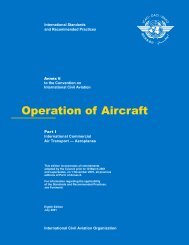Aircraft Operations
Doc 8168 Aircraft Operations, Volume I Flight Procedures
Doc 8168 Aircraft Operations, Volume I Flight Procedures
- No tags were found...
Create successful ePaper yourself
Turn your PDF publications into a flip-book with our unique Google optimized e-Paper software.
I-6-1-4<br />
Procedures — <strong>Aircraft</strong> <strong>Operations</strong> — Volume I<br />
2) along a published track; and<br />
3) by radar vectoring, when aircraft must be established on prescribed protected flight paths.<br />
b) The entry point may be either of the following two options:<br />
1) the holding fix: In this case, the aircraft will arrive at the entry point by means of:<br />
i) the VOR radial for the inbound leg; or<br />
ii) the DME arc defining the holding fix.<br />
2) the fix at the end of the outbound leg: In this case, the aircraft will arrive at the entry point by means of the<br />
VOR radial passing through the fix at the end of the outbound leg.<br />
1.4.8.2 It is also possible to make use of guidance from another radio facility (e.g. NDB). In that case, protection<br />
of the entry should be the subject of a special study based on general criteria.<br />
1.4.8.3 The radius of a DME arc used as guidance for arrival at a VOR/DME holding should be not less than<br />
18.5 km (10 NM).<br />
1.4.8.4 Minimum length for the last segment of the arrival track<br />
The minimum length for the last segment of the arrival track, which terminates at the entry point, depends on the angle<br />
() between that segment and the preceding segment (or radar path). The various values are shown in Table I-6-1-3.<br />
1.4.8.5 Method of arrival at a VOR/DME holding and the corresponding entry procedures<br />
Where the entry point is the holding fix:<br />
a) Arrival on the VOR radial for the inbound leg, on the same heading as the inbound track (see Figure I-6-1-3 A).<br />
The arrival path (or its last segment) is aligned with the inbound track and follows the same heading. The entry<br />
consists of following the holding pattern.<br />
b) Arrival on the VOR radial for the inbound leg, on a heading reciprocal to the inbound track (see<br />
Figure I-6-1-3-B).<br />
1) On arrival over the holding fix, the aircraft turns onto the holding side on a track making an angle of 30°<br />
with the reciprocal of the inbound track, until reaching the DME outbound limiting distance.<br />
2) At this point it turns to intercept the inbound track.<br />
3) In the case of a VOR/DME holding entry away from the facility with a limiting radial, if the aircraft<br />
encounters the radial ahead of the DME distance, it must turn and follow it until reaching the DME<br />
outbound limiting distance, at which point it turns to join the inbound track.<br />
c) Arrival on the DME arc defining the holding fix, from the non-holding side (see Figure I-6-1-3 C).<br />
1) On arrival over the holding fix, the aircraft turns and follows a track parallel to and on the same heading as<br />
the outbound track.<br />
23/11/06












